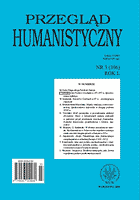W STRONĘ KULTURY WYSOKIEJ ROZWÓJ KOMIKSU W POLSCE PO 1956 ROKU
HEADING TOWARDS HIGHT CULTURE. EVOLUTION OF COMIC STRIP AND COMIC BOOK IN POLAND AFTER 1956
Author(s): Andrzej ZugajSubject(s): Cultural Essay, Political Essay, Societal Essay
Published by: Wydawnictwa Uniwersytetu Warszawskiego
Keywords: kultura wysoka; komiks; Max und Moritz; Wilhelm Busch; R. F. Outcault; The Yellow Kid; Tytus; Romek i A'tomek; Kajko i Kokosz; Kapitan Żbik; komiks w Internecie
Summary/Abstract: The invention of comics was an answer to the easiest skill of human perception: thinking in pictures. From prehistoric cave paintings (Lascaux, Altamira), through hieroglyphs, medieval illustrated books, to TV and the Internet, people have used this possibility to record the past for future generations in the most understandable way. The first comic strips were published in the second half of the 19th century. It is not possible to say which work was the first; in Europe it was probably Max und Moritz (1865) by Wilhelm Busch, in America – The Yellow Kid (1896) by R.F. Outcault. The United States of America is considered the homeland of comics, but Europe also has important artists which formed this genre in the 20th century. Polish comics are not the most famous in the world, however, very interesting comic book output has appeared after 1956. At first comics were invented for children as easier to read than literature. Despite that fact, comic books have soon reached larger audience. One of the first and most popular comic books is Tytus, Romek i A’tomek created by H.J. Chmielewski. The title started in 1957 and new series have been published until now. The first series were meant to be didactic and politically correct. Chmielewski managed to play cat and mouse with the censors and put some critical humor in his stories. There were many comic series of People’s Republic of Poland period which were very popular and which are still reissued, as Kajko i Kokosz or Kapitan Żbik. The last mentioned title was created in cooperation with Polish government for propaganda purposes. Kapitan Żbik was a story of the model militia (police officer, who was brave, fair and always right. After 1989, when People’s Republic became “The 3rd Republic of Poland”, Polish comics disappeared for almost ten years. American and European output began to be published as forbidden beforehand. It took few years to adapt to new political and economical conditions and start publishing fresh new comics by young artists. Following Spiegelman’s Maus, comicsbecame more serious and focused on adult and adolescent audience rather than children. One of the best titles is Osiedle Swoboda (Housing Estate Freedom), a black and white comic book descrbing young people in Poland living in the suburbs at the end of the 20 centuryth . Comics have been evolving from silly cartoons for children and newspaper picture jokes, to an important genre between art and literature, which is becoming more and more appreciated. Possibly, it will become a part of high culture very soon.
Journal: Przegląd Humanistyczny
- Issue Year: 427/2010
- Issue No: 01
- Page Range: 125-136
- Page Count: 12
- Language: Polish
- Content File-PDF

